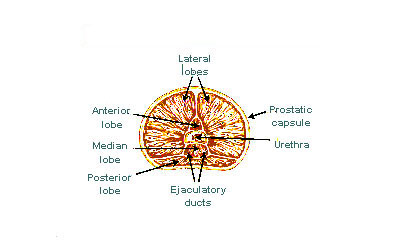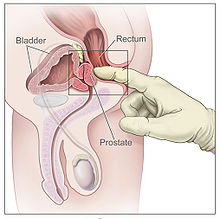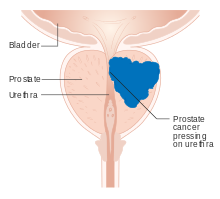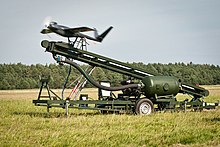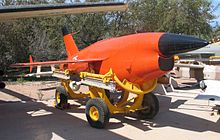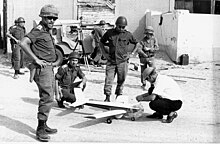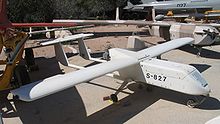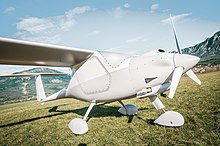From Wikipedia, the free encyclopedia
A DeltaQuad VTOL fixed wing surveillance UAV
An
unmanned aerial vehicle (
UAV) (or
uncrewed aerial vehicle, commonly known as a
drone) is an
aircraft without a human
pilot on board and a type of
unmanned vehicle. UAVs are a component of an
unmanned aircraft system (UAS);
which include a UAV, a ground-based controller, and a system of
communications between the two. The flight of UAVs may operate with
various degrees of
autonomy: either under remote control by a human operator or autonomously by onboard computers.
Compared to crewed aircraft, UAVs were originally used for missions too "dull, dirty or dangerous"
for humans. While they originated mostly in military applications,
their use is rapidly expanding to commercial, scientific, recreational,
agricultural, and other applications, such as policing and surveillance,
product deliveries,
aerial photography, smuggling, and
drone racing. Civilian UAVs now vastly outnumber military UAVs, with estimates of over a million sold by 2015.
Terminology
Multiple terms are used for unmanned aerial vehicles, which generally refer to the same concept.
A UAV is defined as a "powered, aerial vehicle that does not carry a human operator, uses
aerodynamic forces
to provide vehicle lift, can fly autonomously or be piloted remotely,
can be expendable or recoverable, and can carry a lethal or nonlethal
payload". Therefore,
missiles
are not considered UAVs because the vehicle itself is a weapon that is
not reused, though it is also uncrewed and in some cases remotely
guided.
The relation of UAVs to
remote controlled model aircraft is unclear. UAVs may or may not include model aircraft. Some jurisdictions base their definition on size or weight; however, the US
Federal Aviation Administration
defines any uncrewed flying craft as a UAV regardless of size. For
recreational uses, a drone (as opposed to a UAV) is a model aircraft
that has first-person video, autonomous capabilities, or both.
History
Last
preparations before the first tactical UVA mission across the Suez
canal (1969). Standing: Major Shabtai Brill from the Israeli
intelligence corps, the innovator of the tactical UAV.
The Israeli Tadiran Mastiff,
which first flew in 1975, is seen by many as the first modern
battlefield UAV, due to its data-link system, endurance-loitering, and
live video-streaming.
The earliest recorded use of an unmanned aerial vehicle for warfighting occurred on July 1849, serving as a
balloon carrier (the precursor to the
aircraft carrier) in the first offensive use of
air power in
naval aviation. Austrian forces besieging Venice attempted to launch some 200
incendiary balloons at the besieged city. The balloons were launched mainly from land; however, some were also launched from the Austrian ship
SMS Vulcano.
At least one bomb fell in the city; however, due to the wind changing
after launch, most of the balloons missed their target, and some drifted
back over Austrian lines and the launching ship
Vulcano.
UAV innovations started in the early 1900s and originally focused
on providing practice targets for training military personnel. UAV
development continued during
World War I, when the
Dayton-Wright Airplane Company invented a pilotless
aerial torpedo that would explode at a preset time.
The earliest attempt at a powered UAV was
A. M. Low's "Aerial Target" in 1916.
Nikola Tesla described a fleet of uncrewed aerial combat vehicles in 1915. Advances followed during and after World War I, including the
Hewitt-Sperry Automatic Airplane. This development also inspired the development of the
Kettering Bug
by Charles Kettering from Dayton, Ohio. This was initially meant as an
uncrewed plane that would carry an explosive payload to a predetermined
target. The first scaled remote piloted vehicle was developed by film
star and
model-airplane enthusiast
Reginald Denny in 1935. More emerged during
World War II – used both to train antiaircraft gunners and to fly attack missions.
Nazi Germany produced and used various UAV aircraft during the war.
Jet engines entered service after World War II in vehicles such as the Australian
GAF Jindivik, and
Teledyne Ryan Firebee I of 1951, while companies like
Beechcraft offered their
Model 1001 for the
U.S. Navy in 1955. Nevertheless, they were little more than remote-controlled airplanes until the
Vietnam War.
During the
War of Attrition (1967–1970) the first tactical UAVs installed with
reconnaissance
cameras were first tested by the Israeli intelligence, successfully
bringing photos from across the Suez canal. This was the first time that
tactical UAVs, which could be launched and landed on any short runway
(unlike the heavier jet-based UAVs), were developed and tested in
battle.
In the 1973
Yom Kippur War,
Israel used UAVs as decoys to spur opposing forces into wasting expensive anti-aircraft missiles.
After the 1973 Yom Kippur war, a few key people from the team that
developed this early UAV joined a small startup company that aimed to
develop UAVs into a commercial product, eventually purchased by Tadiran
and leading to the development of the first Israeli UVA.
In 1973, the U.S. military officially confirmed that they had been using UAVs in Southeast Asia (Vietnam). Over 5,000 U.S. airmen had been killed and over 1,000 more were
missing or
captured. The USAF
100th Strategic Reconnaissance Wing flew about 3,435 UAV missions during the war at a cost of about 554 UAVs lost to all causes. In the words of USAF
General George S. Brown, Commander,
Air Force Systems Command, in 1972, "The only reason we need (UAVs) is that we don't want to needlessly expend the man in the cockpit." Later that year, General
John C. Meyer, Commander in Chief,
Strategic Air Command,
stated, "we let the drone do the high-risk flying ... the loss rate is
high, but we are willing to risk more of them ...they save lives!"
During the 1973
Yom Kippur War, Soviet-supplied
surface-to-air missile batteries in
Egypt and
Syria caused heavy damage to Israeli
fighter jets. As a result, Israel developed the first UAV with real-time surveillance. The images and radar decoys provided by these UAVs helped Israel to
completely neutralize the Syrian
air defenses at the start of the
1982 Lebanon War, resulting in no pilots downed.
The first time UAVs were used as proof-of-concept of super-agility
post-stall controlled flight in combat-flight simulations involved
tailless, stealth technology-based, three-dimensional thrust vectoring
flight control, jet-steering UAVs in Israel in 1987.
With the maturing and miniaturization of applicable technologies
in the 1980s and 1990s, interest in UAVs grew within the higher echelons
of the U.S. military. In the 1990s, the U.S. DoD gave a contract to
AAI Corporation
along with Israeli company Malat. The U.S. Navy bought the AAI Pioneer
UAV that AAI and Malat developed jointly. Many of these UAVs saw service
in the
1991 Gulf War.
UAVs demonstrated the possibility of cheaper, more capable fighting
machines, deployable without risk to aircrews. Initial generations
primarily involved
surveillance aircraft, but
some carried armaments, such as the
General Atomics MQ-1 Predator, that launched
AGM-114 Hellfire air-to-ground missiles.
In 2013 at least 50 countries used UAVs. China, Iran, Israel, Pakistan, and others designed and built their own varieties.
Classification
UAVs typically fall into one of six functional categories (although multi-role airframe platforms are becoming more prevalent):
- Target and decoy – providing ground and aerial gunnery a target that simulates an enemy aircraft or missile
- Reconnaissance – providing battlefield intelligence
- Combat – providing attack capability for high-risk missions (see: Unmanned combat aerial vehicle (UCAV))
- Logistics – delivering cargo
- Research and development – improve UAV technologies
- Civil and commercial UAVs – agriculture, aerial photography, data collection
Northrop Grumman Bat carrying EO/IR and SAR sensors, laser range finders, laser designators, Infra-Red cameras
Vehicles can be categorized in terms of range/altitude. The following has been advanced as relevant at industry events such as
ParcAberporth Unmanned Systems forum:
- Hand-held 2,000 ft (600 m) altitude, about 2 km range
- Close 5,000 ft (1,500 m) altitude, up to 10 km range
- NATO type 10,000 ft (3,000 m) altitude, up to 50 km range
- Tactical 18,000 ft (5,500 m) altitude, about 160 km range
- MALE (medium altitude, long endurance) up to 30,000 ft (9,000 m) and range over 200 km
- HALE (high altitude, long endurance) over 30,000 ft (9,100 m) and indefinite range
- Hypersonic high-speed, supersonic (Mach 1–5) or hypersonic (Mach 5+)
50,000 ft (15,200 m) or suborbital altitude, range over 200 km
- Orbital low earth orbit (Mach 25+)
- CIS Lunar Earth-Moon transfer
- Computer Assisted Carrier Guidance System (CACGS) for UAVs
U.S. UAV demonstrators in 2005
- Hobbyist UAVs – which can be further divided into
- Ready-to-fly (RTF)/Commercial-off-the-shelf (COTS)
- Bind-and-fly (BNF) – require minimum knowledge to fly the platform
- Almost-ready-to-fly (ARF)/Do-it-yourself (DIY) – require significant knowledge to get in the air
- Bare frame – requires significant knowledge and your own parts to get it in the air
- Midsize military and commercial UAVs
- Large military-specific UAVs
- Stealth combat UAVs
- Crewed aircraft transformed into uncrewed (and Optionally Piloted UAVS or OPVs)
Classifications according to aircraft weight are quite simpler:
- Micro air vehicle (MAV) – the smallest UAVs that can weigh less than 1g
- Miniature UAV (also called SUAS) – approximately less than 25 kg
- Heavier UAVs
UAV components
Crewed and uncrewed aircraft of the same type generally have
recognizably similar physical components. The main exceptions are the
cockpit and
environmental control system or
life support systems.
Some UAVs carry payloads (such as a camera) that weigh considerably
less than an adult human, and as a result can be considerably smaller.
Though they carry heavy payloads, weaponized military UAVs are lighter
than their crewed counterparts with comparable armaments.
Small civilian UAVs have no
life-critical systems,
and can thus be built out of lighter but less sturdy materials and
shapes, and can use less robustly tested electronic control systems. For
small UAVs, the
quadcopter
design has become popular, though this layout is rarely used for crewed
aircraft. Miniaturization means that less-powerful propulsion
technologies can be used that are not feasible for crewed aircraft, such
as small electric motors and batteries.
Control systems for UAVs are often different than crewed craft.
For remote human control, a camera and video link almost always replace
the cockpit windows; radio-transmitted digital commands replace physical
cockpit controls.
Autopilot software is used on both crewed and uncrewed aircraft, with varying feature sets.
Body
The primary
difference for planes is the absence of the cockpit area and its
windows. Tailless quadcopters are a common form factor for rotary wing
UAVs while tailed mono- and bi-copters are common for crewed platforms.
Power supply and platform
Small UAVs mostly use
lithium-polymer batteries
(Li-Po), while larger vehicles rely on conventional airplane engines.
Scale or size of aircraft is not the defining or limiting characteristic
of energy supply for a UAV. At present,
the energy density of Li-Po is far less than gasoline. The record of
travel for a UAV (built from balsa wood and mylar skin) across the North
Atlantic Ocean is held by a gasoline model airplane or UAV. Manard Hill
in "in 2003 when one of his creations flew 1,882 miles across the
Atlantic Ocean on less than a gallon of fuel" holds this record. Electric power is used as less work is required for a flight and
electric motors are quieter. Also, properly designed, the thrust to
weight ratio for an electric or gasoline motor driving a propeller can
hover or climb vertically. Botmite airplane is an example of an electric
UAV which can climb vertically.
Computing
UAV
computing capability followed the advances of computing technology,
beginning with analog controls and evolving into microcontrollers, then
system-on-a-chip (SOC) and
single-board computers (SBC).
System hardware for small UAVs is often called the flight controller (FC), flight controller board (FCB) or autopilot.
Sensors
Position
and movement sensors give information about the aircraft state.
Exteroceptive sensors deal with external information like distance
measurements, while exproprioceptive ones correlate internal and
external states.
Non-cooperative sensors are able to detect targets autonomously
so they are used for separation assurance and collision avoidance.
Degrees of freedom (DOF) refers to both the amount and quality of
sensors on board: 6 DOF implies 3-axis gyroscopes and accelerometers (a
typical
inertial measurement unit – IMU), 9 DOF refers to an IMU plus a compass, 10 DOF adds a barometer and 11 DOF usually adds a GPS receiver.
Actuators
Software
Flight stack overview
| Layer
|
Requirement
|
Operations
|
Example
|
| Firmware
|
Time-critical
|
From machine code to processor execution, memory access
|
ArduCopter-v1, px4
|
| Middleware
|
Time-critical
|
Flight control, navigation, radio management
|
Cleanflight, ArduPilot
|
| Operating system
|
Computer-intensive
|
Optic flow, obstacle avoidance, SLAM, decision-making
|
ROS, Nuttx, Linux distributions, Microsoft IOT
|
Civil-use open-source stacks include:
Loop principles
Typical flight-control loops for a multirotor
UAVs employ open-loop, closed-loop or hybrid control architectures.
- Open loop –
This type provides a positive control signal (faster, slower, left,
right, up, down) without incorporating feedback from sensor data.
- Closed loop –
This type incorporates sensor feedback to adjust behavior (reduce
speed to reflect tailwind, move to altitude 300 feet). The PID controller is common. Sometimes, feedforward is employed, transferring the need to close the loop further.
Flight controls
UAVs can be programmed to perform aggressive manœuvres or landing/perching on inclined surfaces, and then to climb toward better communication spots. Some UAVs can control flight with varying flight modelisation, such as VTOL designs.
UAVs can also implement perching on a flat vertical surface.
Communications
Most UAVs use a
radio for remote control and
exchange of video and other data. Early UAVs had only
narrowband uplink. Downlinks came later. These bi-directional narrowband radio links carried command and control (C&C) and
telemetry data about the status of aircraft systems to the remote operator. For very long range flights, military UAVs also use
satellite receivers as part of
satellite navigation systems. In cases when video transmission was required, the UAVs will implement a separate analog video radio link.
In the most modern UAV applications, video transmission is
required. So instead of having 2 separate links for C&C, telemetry
and video traffic, a
broadband link is used to carry all types of data on a single radio link. These broadband links can leverage
quality of service techniques to optimize the C&C traffic for low latency. Usually these broadband links carry
TCP/IP traffic that can be routed over the Internet.
The radio signal from the operator side can be issued from either:
- Ground control – a human operating a radio transmitter/receiver, a smartphone, a tablet, a computer, or the original meaning of a military ground control station (GCS). Recently control from wearable devices, human movement recognition, human brain waves was also demonstrated.
- Remote network system, such as satellite duplex data links for some military powers. Downstream digital video over mobile networks has also entered consumer markets, while direct UAV control uplink over the cellular mesh and LTE have been demonstrated and are in trials.
- Another aircraft, serving as a relay or mobile control station – military manned-unmanned teaming (MUM-T).
- A protocol MAVLink is increasingly becoming popular to carry command and control data between the ground control and the vehicle
Autonomy
Autonomous control basics
ICAO classifies uncrewed aircraft as either remotely piloted aircraft or fully autonomous.
Actual UAVs may offer intermediate degrees of autonomy. E.g., a vehicle
that is remotely piloted in most contexts may have an autonomous
return-to-base operation.
Basic autonomy comes from proprioceptive sensors. Advanced
autonomy calls for situational awareness, knowledge about the
environment surrounding the aircraft from exterioceptive sensors:
sensor fusion integrates information from multiple sensors.
Basic principles
One way to achieve autonomous control employs multiple control-loop layers, as in
hierarchical control systems.
As of 2016 the low-layer loops (i.e. for flight control) tick as fast
as 32,000 times per second, while higher-level loops may cycle once per
second. The principle is to decompose the aircraft's behavior into
manageable "chunks", or states, with known transitions. Hierarchical
control system types range from simple
scripts to
finite state machines,
behavior trees and
hierarchical task planners. The most common control mechanism used in these layers is the
PID controller which can be used to achieve hover for a
quadcopter by using data from the
IMU to calculate precise inputs for the electronic speed controllers and motors.
Examples of mid-layer algorithms:
- Path planning: determining an optimal path for vehicle to follow
while meeting mission objectives and constraints, such as obstacles or
fuel requirements
- Trajectory generation (motion planning): determining control maneuvers to take in order to follow a given path or to go from one location to another
- Trajectory regulation: constraining a vehicle within some tolerance to a trajectory
Autonomy features
UAV's degrees of autonomy
UAV manufacturers often build in specific autonomous operations, such as:
- Self-level: attitude stabilization on the pitch and roll axes.
- Altitude hold: The aircraft maintains its altitude using barometric or ground sensors.
- Hover/position hold: Keep level pitch and roll, stable yaw heading and altitude while maintaining position using GNSS or inertal sensors.
- Headless mode: Pitch control relative to the position of the pilot rather than relative to the vehicle's axes.
- Care-free: automatic roll and yaw control while moving horizontally
- Take-off and landing (using a variety of aircraft or ground-based sensors and systems; see also:Autoland)
- Failsafe: automatic landing or return-to-home upon loss of control signal
- Return-to-home: Fly back to the point of takeoff (often gaining
altitude first to avoid possible intervening obstructions such as trees
or buildings).
- Follow-me: Maintain relative position to a moving pilot or other object using GNSS, image recognition or homing beacon.
- GPS waypoint navigation: Using GNSS to navigate to an intermediate location on a travel path.
- Orbit around an object: Similar to Follow-me but continuously circle a target.
- Pre-programmed aerobatics (such as rolls and loops)
Functions
Full autonomy is available for specific tasks, such as airborne refueling
or ground-based battery switching; but higher-level tasks call for
greater computing, sensing and actuating capabilities. One approach to
quantifying autonomous capabilities is based on
OODA terminology, as suggested by a 2002 US Air Force Research Laboratory.
United States Autonomous control levels chart
Medium levels of autonomy, such as reactive autonomy
and high levels using cognitive autonomy, have already been achieved to
some extent and are very active research fields.
Reactive autonomy
Most range sensors analyze electromagnetic radiation, reflected
off the environment and coming to the sensor. The cameras (for visual
flow) act as simple receivers. Lidars, radars and sonars (with sound
mechanical waves) emit and receive waves, measuring the round-trip
transit time. UAV cameras do not require emitting power, reducing total
consumption.
Radars and sonars are mostly used for military applications.
Reactive autonomy has in some forms already reached consumer markets: it may be widely available in less than a decade.
Cutting-edge (2013) autonomous levels for existing systems
Simultaneous localization and mapping
SLAM combines
odometry
and external data to represent the world and the position of the UAV in
it in three dimensions. High-altitude outdoor navigation does not
require large vertical fields-of-view and can rely on GPS coordinates
(which makes it simple mapping rather than SLAM).
Two related research fields are
photogrammetry and LIDAR, especially in low-altitude and indoor 3D environments.
Swarming
Robot swarming
refers to networks of agents able to dynamically reconfigure as
elements leave or enter the network. They provide greater flexibility
than multi-agent cooperation. Swarming may open the path to data fusion.
Some
bio-inspired flight swarms use steering behaviors and flocking.
Future military potential
In the military sector, American
Predators and
Reapers are made for
counterterrorism
operations and in war zones in which the enemy lacks sufficient
firepower to shoot them down. They are not designed to withstand
antiaircraft defenses or
air-to-air combat. In September 2013, the chief of the US
Air Combat Command
stated that current UAVs were "useless in a contested environment"
unless crewed aircraft were there to protect them.[167] A 2012
Congressional Research Service
(CRS) report speculated that in the future, UAVs may be able to perform
tasks beyond intelligence, surveillance, reconnaissance and strikes;
the CRS report listed air-to-air combat ("a more difficult future task")
as possible future undertakings.[168] The Department of Defense's
Unmanned Systems Integrated Roadmap FY2013-2038 foresees a more
important place for UAVs in combat.[169] Issues include extended
capabilities, human-UAV interaction, managing increased information
flux, increased autonomy and developing UAV-specific munitions.[169]
DARPA's project of systems of systems, or
General Atomics work may augur future warfare scenarios, the latter disclosing
Avenger swarms equipped with
High Energy Liquid Laser Area Defense System (HELLADS).
Cognitive radio
Learning capabilities
Market
Military
The
global military UAV market is dominated by companies based in the
United States and Israel. By sale numbers, The US held over 60%
military-market share in 2017. Four of top five military UAV
manufactures are American including General Atomics,
Lockheed Martin,
Northrop Grumman and
Boeing, followed by the Chinese company
CASC.
Israel companies mainly focus on small surveillance UAV system and by
quantity of drones, Israel exported 60.7% (2014) of UAV on the market
while the United States export 23.9% (2014); top importers of military
UAV are The United Kingdom (33.9%) and India (13.2%). United States
alone operated over 9,000 military UAVs in 2014. General Atomics is the dominant manufacturer with the Global Hawk and Predator/Mariner systems product-line.
Civilian
The civilian drone market is dominated by Chinese companies. Chinese drone manufacturer
DJI alone has 75% of civilian-market share in 2017 with $11 billion forecast global sales in 2020. Followed by French company Parrot with $110m and US company 3DRobotics with $21.6m in 2014.
As of March 2018, more than one million UAVs (878,000 hobbyist and
122,000 commercial) were registered with the U.S. FAA. 2018 NPD point to
consumers increasingly purchasing drones with more advanced features
with 33 percent growth in both the $500+ and $1000+ market segments.
The civilian UAV market is relatively new compared to the
military one. Companies are emerging in both developed and developing
nations at the same time. Many early stage startups have received
support and funding from investors as is the case in the United States
and by government agencies as is the case in India. Some universities offer research and training programs or degrees. Private entities also provide online and in-person training programs for both recreational and commercial UAV use.
Consumer drones are also widely used by military organizations
worldwide because of the cost-effective nature of consumer product. In
2018, Israeli military started to use
DJI Mavic
and Matrice series of UAV for light reconnaissance mission since the
civilian drones are easier to use and have higher reliability. DJI
drones is also the most widely used commercial unmanned aerial system
that the US Army has employed.
The global UAV market will reach US$21.47 billion, with the Indian market touching the US$885.7 million mark, by 2021.
Lighted drones are beginning to be used in nighttime
displays for artistic and advertising purposes.
Transport
The
AIA reports large cargo and passengers drones should be certified and introduced over the next 20 years.
Sensor-carrying large drones are expected from 2018;
short-haul, low altitude freighters outside cities from 2025;
long-haul cargo flights by the mid-2030s and then passenger flights by 2040.
Spending should rise from a few hundred million dollars on
research and development in 2018 to $4 billion by 2028 and $30 billion by 2036.
Agriculture
As
global food production demand grows exponentially, resources are
depleted, farmland is reduced, and agricultural labor is increasingly in
short supply, there is an urgent need for more convenient and smarter
agricultural solutions than traditional methods, and the agricultural
drone and robotics industry is expected to make progress. In the world, agricultural drones have been used in areas such as Africa, which can help build sustainable agriculture.
Development considerations
Animal imitation – ethology
Flapping-wing
ornithopters, imitating birds or insects, are a research field in
microUAVs. Their inherent stealth recommends them for spy missions.
The Nano Hummingbird is commercially available, while sub-1g
microUAVs inspired by flies, albeit using a power tether, can "land" on
vertical surfaces.
Other projects include uncrewed "beetles" and other insects.
Research is exploring miniature optic-flow sensors, called
ocellis, mimicking the compound insect eyes formed from multiple facets, which can transmit data to
neuromorphic chips able to treat optic flow as well as light intensity discrepancies.
Endurance
UEL UAV-741 Wankel engine for UAV operations
Flight time against mass of small (less than 1 kg) drones
UAV endurance is not constrained by the physiological capabilities of a human pilot.
Because of their small size, low weight, low vibration and high power to weight ratio,
Wankel rotary engines
are used in many large UAVs. Their engine rotors cannot seize; the
engine is not susceptible to shock-cooling during descent and it does
not require an enriched fuel mixture for cooling at high power. These
attributes reduce fuel usage, increasing range or payload.
Proper drone cooling is essential for long-term drone endurance.
Overheating and subsequent engine failure is the most common cause of
drone failure.
Hydrogen fuel cells, using hydrogen power, may be able to extend the endurance of small UAVs, up to several hours.
Micro air vehicles endurance is so far best achieved with
flapping-wing UAVs, followed by planes and multirotors standing last,
due to lower
Reynolds number.
Solar-electric UAVs, a concept originally championed by the
AstroFlight Sunrise in 1974, have achieved flight times of several
weeks.
Solar-powered atmospheric satellites ("atmosats") designed for
operating at altitudes exceeding 20 km (12 miles, or 60,000 feet) for as
long as five years could potentially perform duties more economically
and with more versatility than
low earth orbit satellites. Likely applications include
weather monitoring,
disaster recovery,
earth imaging and communications.
Electric UAVs powered by microwave power transmission or laser power beaming are other potential endurance solutions.
Another application for a high endurance UAV would be to "stare"
at a battlefield for a long interval (ARGUS-IS, Gorgon Stare, Integrated
Sensor Is Structure) to record events that could then be played
backwards to track battlefield activities.
Reliability
Individual reliability covers robustness of flight controllers,
to ensure safety without excessive redundancy to minimize cost and
weight. Besides, dynamic assessment of
flight envelope allows damage-resilient UAVs, using
non-linear analysis with ad-hoc designed loops or neural networks. UAV software liability is bending toward the design and certifications of
crewed avionics software.
Swarm resilience involves maintaining operational capabilities and reconfiguring tasks given unit failures.
Applications
There are numerous civilian, commercial, military, and aerospace applications for UAVs. These include:
- Civil
- Recreation, Disaster relief, archeology, conservation of biodiversity and habitat, law enforcement, crime, and terrorism,
-
- Commercial
- Aerial surveillance, filmmaking, journalism, scientific research, surveying, cargo transport, mining , Transmission and Distribution , Forestry and agriculture
-
- Military
- Reconnaissance, attack, demining, and target practice
Existing UAVs
UAVs are being developed and deployed by many countries around the
world. Due to their wide proliferation, no comprehensive list of UAV
systems exists.
Safety and security
US Department of Agriculture poster warning about the risks of flying UAVs near wildfires
Air traffic
UAVs
can threaten airspace security in numerous ways, including
unintentional collisions or other interference with other aircraft,
deliberate attacks or by distracting pilots or flight controllers. The
first incident of a drone-airplane collision occurred in mid-October
2017 in Quebec City, Canada. The first recorded instance of a drone collision with a
hot air balloon occurred on 10 August 2018 in
Driggs, Idaho,
United States; although there was no significant damage to the balloon
nor any injuries to its 3 occupants, the balloon pilot reported the
incident to the
NTSB,
stating that "I hope this incident helps create a conversation of
respect for nature, the airspace, and rules and regulations". In recent events UAVs flying into or near airports shutting them down for long periods of time.
Malicious use
UAVs
could be loaded with dangerous payloads, and crashed into vulnerable
targets. Payloads could include explosives, chemical, radiologial or
biological hazards. UAVs with generally non-lethal payloads could
possibly be hacked and put to malicious purposes. Anti-UAV systems are
being developed by states to counter this threat. This is, however,
proving difficult. As Dr J. Rogers stated in an interview to A&T
"There is a big debate out there at the moment about what the best way
is to counter these small UAVs, whether they are used by hobbyists
causing a bit of a nuisance or in a more sinister manner by a terrorist
actor".
Counter unmanned air system
Italian Army soldiers of the 17th Anti-aircraft Artillery Regiment "Sforzesca" with a portable CPM-Drone Jammer in Rome
The malicious use of UAVs has led to the development of
counter unmanned air system (C-UAS) technologies such as the Aaronia
AARTOS which have been installed on major international airports . Anti-aircraft missile systems, such as the
Iron Dome are also being enhanced with C-UAS technologies.
Security vulnerabilities
The interest in UAVs cyber security has been raised greatly after the Predator UAV video stream hijacking incident in 2009,
where Islamic militants used cheap, off-the-shelf equipment to stream
video feeds from a UAV. Another risk is the possibility of hijacking or
jamming a UAV in flight. Several security researchers have made public
some vulnerabilities in commercial UAVs, in some cases even providing
full source code or tools to reproduce their attacks. At a workshop on UAVs and privacy in October 2016, researchers from the
Federal Trade Commission showed they were able to hack into three different consumer
quadcopters
and noted that UAV manufacturers can make their UAVs more secure by the
basic security measures of encrypting the Wi-Fi signal and adding
password protection.
Wildfires
In
the United States, flying close to a wildfire is punishable by a maximum
$25,000 fine. Nonetheless, in 2014 and 2015, firefighting air support
in California was hindered on several occasions, including at the
Lake Fire and the
North Fire.
In response, California legislators introduced a bill that would allow
firefighters to disable UAVs which invaded restricted airspace. The FAA later required registration of most UAVs.
The use of UAVs is also being investigated to help detect and
fight wildfires, whether through observation or launching pyrotechnic
devices to start
backfires.
Regulation
Ethical concerns and UAV-related accidents have driven nations to regulate the use of UAVs.
Brazil
In 2017,
the National Civil Aviation Agency (ANAC) regulated the operation of
drones through the Brazilian Special Civil Aviation Regulation No.
94/2017 (RBAC-E No. 94/2017). ANAC's regulation complements the drone
operating rules established by the Airspace Control Department (DECEA)
and the National Telecommunications Agency (ANATEL).
Canada
In 2016,
Transport Canada
proposed the implementation of new regulations that would require all
UAVs over 250 grams to be registered and insured and that operators
would be required to be a minimum age and pass an exam in order to get a
license. Revised regulations are in effect as of June 2019.
Ireland
The
Irish Aviation Authority (IAA) requires all UAVs over 1 kg to be registered with UAVs weighing 4 kg or more requiring a license to be issued by the IAA.
Italy
The ENAC (Ente Nazionale per l'Aviazione Civile), that is, the
Italian Civil Aviation Authority
for technical regulation, certification, supervision and control in the
field of civil aviation, issued on 31 May 2016 a very detailed
regulation for all UAV, determining which types of vehicles can be used,
where, for which purposes, and who can control them. The regulation
deals with the usage of UAV for either commercial and recreational use.
The last version was published on 22 December 2016.
Japan
In 2015,
Civil Aviation Bureau in
Japan
announced that "UA/Drone" (refers to any airplane, rotorcraft, glider
or airship which cannot accommodate any person on board and can be
remotely or automatically piloted) should (A) not fly near or above
airports, (B) not fly over 150 meter above ground/water surface, (C) not
fly over
urban area and
suburb (so only
rural area
is allowed.) UA/drone should be operated manually and at Visual Line of
Sight (VLOS) and so on. UA/drone should not fly near any important
buildings or facilities of the country including nuclear facilities.
UA/drone must follow the Japan Radio Act exactly.
Netherlands
South Africa
In April 2014, the
South African Civil Aviation Authority announced that it would clamp down on the illegal flying of UAVs in South African airspace.
"Hobby drones" with a weight of less than 7 kg at altitudes up to 500m
with restricted visual line-of-sight below the height of the highest
obstacle within 300m of the UAV are allowed. No license is required for
such vehicles.
United Arab Emirates
In
order to fly a drone in Dubai, citizens have to obtain a no objection
certificate from Dubai Civil Aviation Authority (DCAA). This certificate
can be obtained online.
United Kingdom
As of December 2018, UAVs of 20 kilograms (44 lb) or less must fly
within the operator's eyesight. In built up areas, UAVs must be 150 feet
(46 m) away from people and cannot be flown over large crowds or built
up areas.
In July 2018, it became illegal to fly a UAV over 400 feet
(120 m) and to fly within 1 kilometre (0.62 mi) of aircraft, airports
and airfields.
As of 30th November 2019, anyone flying a drone between 250 grams
and 20 kilograms in weight is required to register with the Civil
Aviation Authority (CAA). Pilots require a Flyer ID, and those in
control of the drone require an Operator ID. Regulations apply to both
hobbyist and professional users.
United States
Recreational use
From
21 December 2015, all hobby type UAVs between 250 grams and 25
kilograms needed to be registered with FAA no later than 19 February
2016.
The new FAA UAV registration process includes requirements for:
- Eligible owners must register their UAVs prior to flight. Non-commercial flights are no longer subject to registration.
- If the owner is less than 13 years old, a parent or other responsible person must do the FAA registration.
- UAVs must be marked with the FAA-issued registration number.
- The registration fee is $5. The registration is good for 3 years and can be renewed for an additional 3 years at the $5 rate.
- A single registration applies to all UAVs owned by an individual.
Failure to register can result in civil penalties of up to $27,500 and
criminal penalties of up to $250,000 and/or imprisonment for up to three
years.
Commercial use
On
21 June 2016, the Federal Aviation Administration announced regulations
for commercial operation of small UAS craft (sUAS), those between 0.55
and 55 pounds (about 250 gm to 25 kg) including payload. The rules,
which exclude hobbyists, require the presence at all operations of a
licensed Remote Pilot in Command. Certification of this position,
available to any citizen at least 16 years of age, is obtained solely by
passing a written test and then submitting an application. For those
holding a sport pilot license or higher, and with a current flight
review, a rule-specific exam can be taken at no charge online at the
faasafety.gov website. Other applicants must take a more comprehensive
examination at an aeronautical testing center. All licensees are
required to take a review course every two years. At this time no
ratings for heavier UAS are available.
Commercial operation is restricted to daylight, line-of-sight, under 100 mph, under 400 feet, and
Class G airspace only, and may not fly over people or be operated from a moving vehicle. Some organizations have obtained a waiver or Certificate of Authorization that allows them to exceed these rules. On 20 September 2018,
State Farm Insurance, in partnership with the
Virginia Tech Mid-Atlantic Aviation Partnership and
FAA Integration Pilot Program,
became the first in the United States to fly a UAV
'Beyond-Visual-Line-Of-Sight' (BVLOS) and over people under an FAA Part
107 Waiver. The flight was made at the Virginia Tech Kentland Farms
outside the Blacksburg campus with an SenseFly eBee vehicle,
Pilot-In-Command was Christian Kang, a State Farm Weather Catastrophe
Claims Services employee (Part 107 & 61 pilot).
Additionally, CNN's waiver for UAVs modified for injury prevention to
fly over people, while other waivers allow night flying with special
lighting, or non-line-of-sight operations for agriculture or railroad
track inspection.
Previous to this announcement, any commercial use required a full
pilot's license and an FAA waiver, of which hundreds had been granted.
Government use
The use of UAVs for law-enforcement purposes is regulated at a state level.
In Oregon, law enforcement is allowed to operate non-weaponized
drones without a warrant if there is enough reason to believe that the
current environment poses imminent danger to which the drone can acquire
information or assist individuals. Otherwise, a warrant, with a maximum
period of 30 days of interaction, must be acquired.


